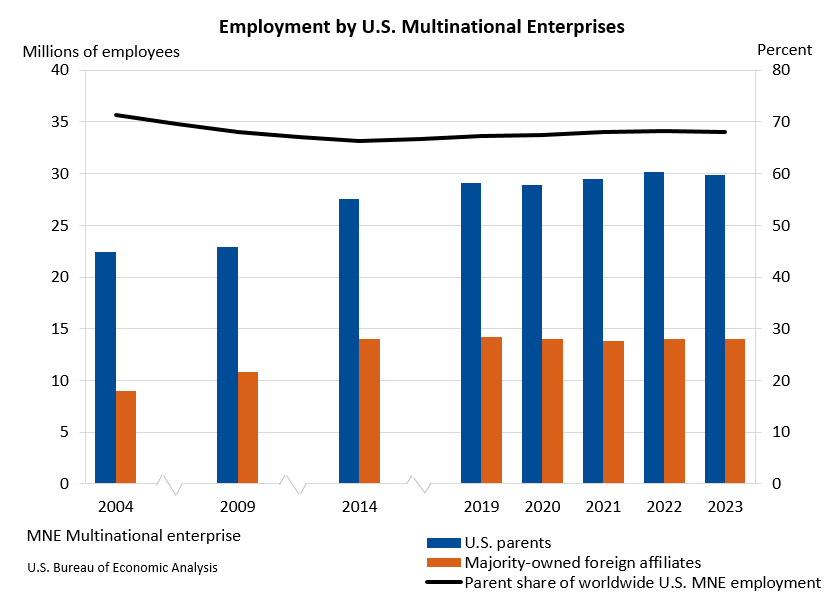Bureau of Economic Analysis
Activities of U.S. Multinational Enterprises, 2023
Worldwide employment by U.S. multinational enterprises decreased 0.4 percent to 43.9 million workers in 2023 (preliminary) from 44.1 million workers in 2022 (revised), according to statistics released today by the U.S. Bureau of Economic Analysis on the operations and finances of U.S. parent companies and their foreign affiliates.
Principal Federal Economic Indicators
Noteworthy
- 2025 News Release Schedule
- Innovation at BEA
- 2025 Annual Updates
- Distribution of Personal Income Nowcast
- New! Services Trade Data for More Countries
- Data Tool: Trade in Value Added
- Updated: RIMS II Regional Multipliers
- Arts and Culture
- Space Economy
- FDI Now in State BEARFACTS
- Quick Guide: Price Indexes
The Latest
Table Changes Coming With Annual Update of International Statistics
In June, BEA will speed up and expand our statistics on U.S. international trade in services, including adding detail on some of the most dynamic services, such as research and development, intellectual property, and financial services.
Real Personal Income by Metropolitan Area, 2018
The percent change in real metropolitan area personal income ranged from 15.6 percent in Midland, TX to -1.1 percent in Sebring-Avon Park, FL.
Real Personal Income by State, 2018
The percent change in real state personal income ranged from 6.7 percent in Wyoming to 0.9 percent in Mississippi.
Real Personal Income by State and Metropolitan Area, 2018
Real state personal income grew 3.4 percent in 2018, after increasing 2.9 percent in 2017, according to estimates released today by the Bureau of Economic Analysis. Real state personal income is a state’s current-dollar personal income adjusted by the state’s regional price parity and the national personal consumption expenditures price index. The percent change in real state personal income ranged from 6.7 percent in Wyoming to 0.9 percent in…
March 2020 Trade Gap is $44.4 Billion
The U.S. monthly international trade deficit increased in March 2020 according to the U.S. Bureau of Economic Analysis and the U.S. Census Bureau. The deficit increased from $39.8 billion in February (revised) to $44.4 billion in March, as exports decreased more than imports. The previously published February deficit was $39.9 billion. The goods deficit increased $4.6 billion in March to $65.6 billion. The services surplus decreased $0.1…
U.S. International Trade in Goods and Services, March 2020
The U.S. monthly international trade deficit increased in March 2020 according to the U.S. Bureau of Economic Analysis and the U.S. Census Bureau. The deficit increased from $39.8 billion in February (revised) to $44.4 billion in March, as exports decreased more than imports. The previously published February deficit was $39.9 billion. The goods deficit increased $4.6 billion in March to $65.6 billion. The services surplus decreased $0.1 billion…
Personal Income and Outlays, March 2020
Personal income decreased 2.0 percent in March after increasing 0.6 percent in February. Wages and salaries, the largest component of personal income, decreased 3.1 percent in March after increasing 0.5 percent in February.
Personal Income and Outlays: March 2020
Personal income decreased 2.0 percent in March after increasing 0.6 percent in February. Wages and salaries, the largest component of personal income, decreased 3.1 percent in March after increasing 0.5 percent in February.
Gross Domestic Product, First Quarter 2020
Real gross domestic product (GDP) decreased 4.8 percent in the first quarter of 2020, according to the “advance” estimate released by the Bureau of Economic Analysis. In the fourth quarter of 2019, real GDP increased 2.1 percent.
Gross Domestic Product, 1st Quarter 2020 (Advance Estimate)
Real gross domestic product (GDP) decreased 4.8 percent in the first quarter of 2020, according to the “advance” estimate released by the Bureau of Economic Analysis. In the fourth quarter of 2019, real GDP increased 2.1 percent.




